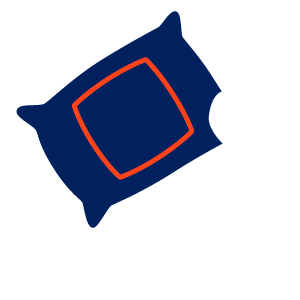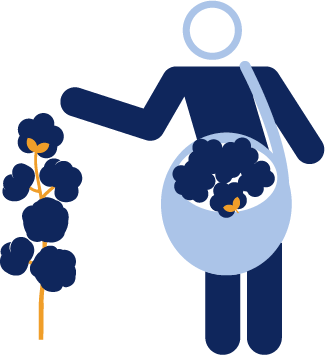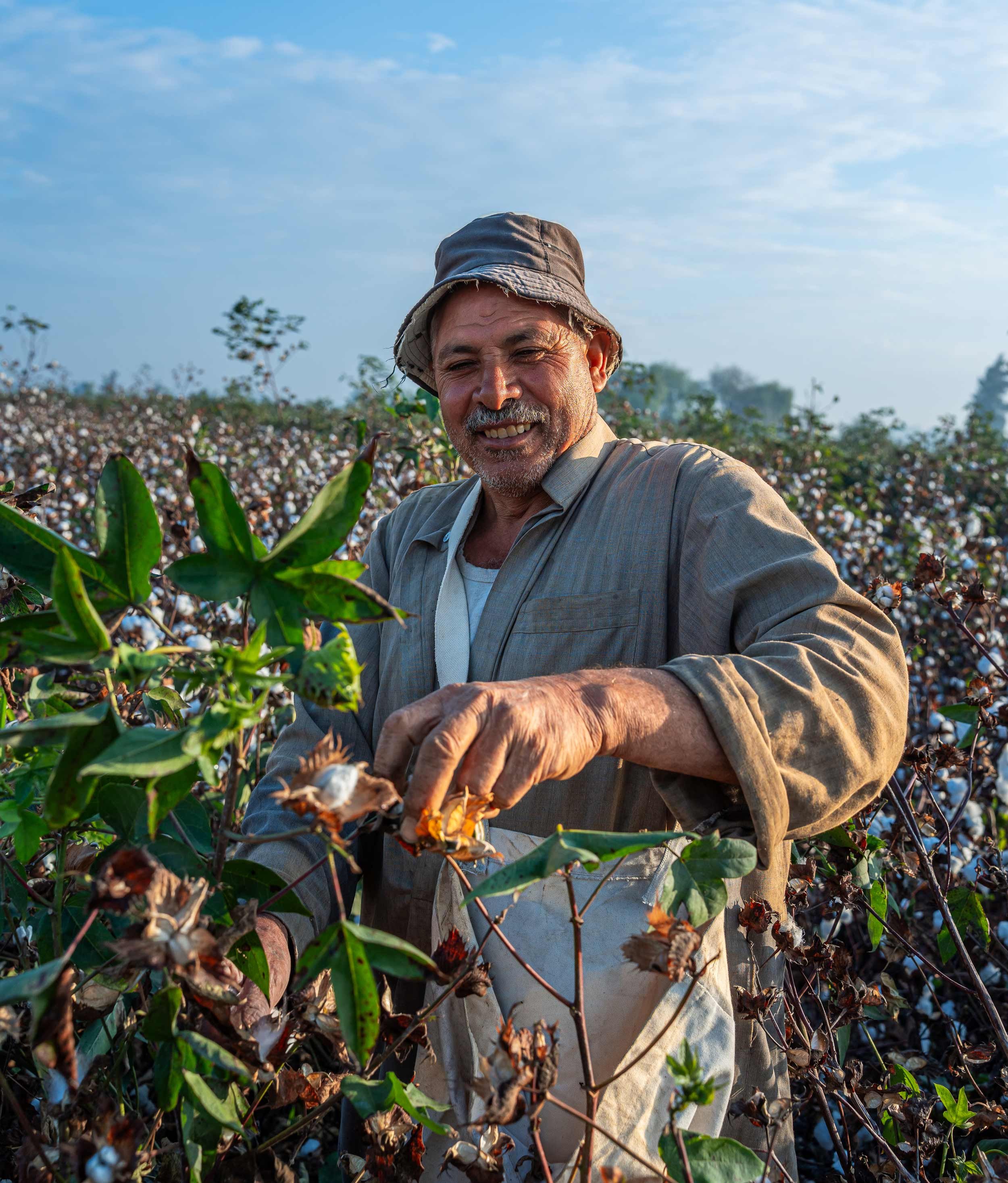
IMPACT REPORT 2024
IMPACT REPORT 2024
✤
IMPACT REPORT 2024 ✤
REEL COTTON HIGHLIGHTS
The results of the REEL Cotton Programme in 2023-24 show a positive reduction in inputs affecting soil health and the environment, compared with control farmers.
21.4%
17.5%
use by
21.9%
6.1%
14.3%
26.1%
The results show an improvement in programme farmers’ income from cotton farming, compared with control farmers.
INTRODUCTION FROM CEO
As we navigate this VUCA (Volatility, Uncertainty, Complexity and Ambiguity) world, a partnership approach is essential for us to work together as a sector. Our working partnerships include brand partners, government associations and representatives, relevant supportive agencies, supply chain actors, our implementing partners, and of course, most importantly, the farmers themselves.
With new legislation and frameworks being implemented across key consumer markets, a focus on assuring the outcomes and impact of our work through strong monitoring and evaluation frameworks is essential. Last year we launched a new portal for our TraceBale system and supported the virtual chain of custody via improvements in the physical chain of custody, including unique QR codes for farmer purchases, and the roll-out of a DNA marker to provide further assurance from gin to garment.
We trained over 250,000 farmers on more regenerative agriculture practices in 2023-24 and have been able to measure demonstrable positive outcomes, including soil health improvements and greater biodiversity. Our move to a REEL Standard in April 2025 will further support the robustness of programme validation and acceptable claims about these outcomes.
Our second LCA study analysed how the outcomes of our sustainable agricultural practices in the REEL Cotton Programme translated into reducing greenhouse gas (GHG) emissions, demonstrating how our work contributes to our clients’ GHG emissions reduction goals. We saw that farm level irrigation and reductions in fertiliser contribute to a saving potential of 1.20 kg CO₂ eq., or 35.39%, per kg fibre.
By sharing these insights, we hope to encourage and help other contributors in the textiles industry to collectively work on increasing responsible production of raw materials and supporting smallholder farmers to attain a resilient future.
Alison Ward
Chief Executive Officer, CottonConnect
OVERVIEW OF COTTONCONNECT
Programmes
Programmes reporting 2023-24 results in this report:
REEL Cotton; REEL Regenerative; Organic Cotton Farmer Training Programme; Regenerative Organic Programme; Responsible Business for Gins
Programmes underway but not reporting 2023-24 results in this report: REEL Linen
CottonConnect is also an implementing partner of Better Cotton, which reports its Farmer Results and Impact Reports at bettercotton.org.
Countries
Location of programmes reporting 2023-24 results in this report: India, Pakistan, Bangladesh, China, Egypt, Türkiye
452,321
Fibres traced through TraceBale in 2023-24:
193,468
Focus Areas
Environment
Climate
Livelihoods
Gender

IMPACT RESULTS 2023-24

REEL COTTON RESULTS
REEL Cotton results for 2023-24 aggregated for all REEL Cotton programmes in India, Pakistan, Bangladesh, China, Egypt, and Türkiye.
6.1%
14.3%
26.1%
21.4%
17.5%
use by
21.9%
KPIs measurements:
Yield (kg/acre), Water use (m³/acre), Pesticides (ml/acre), Fertiliser (kg/acre), Input cost (USD/acre), Profit (USD/Acre)
Sample size:
Approximately 50% sample of the farmers in REEL Cotton training programmes compared with conventional farmers as a control sample of 10% of the sample project farmers.
Verification:
Second-party verified by CottonConnect and third-party verified by FLOCERT.
REEL COTTON LCA RESULTS
Climate change: 35% saving potential in CO₂ eq. Main influencing factors are field emissions, irrigation and use of fertiliser.
Eutrophication: 44% saving potential in phosphate. Main influencing factors are field emissions due to application of fertiliser.
Acidification: 25% saving potential in mol H+ eq. Main influencing factors are field emissions, irrigation and fertiliser application
Water consumption: 36% saving potential in water consumption. Main influencing factor is water use for irrigation on the field.
Water use: 35% saving potential in water use. Main influencing factor is water use for irrigation on the field.
Abiotic depletion potential, fossil: 36% saving potential in MJ. Main influencing factors are use of fossil-based resources in the provision of fertiliser, and irrigation.
Ecotoxicity: 42% saving potential in CTUe. Main influencing factors are crop protection, and provision of fertiliser.
HOW THE RESULTS DEMONSTRATE THE THEORY OF CHANGE
Sustainable Land Management
Improved soil health, plant growth, and increased yields/ profits
Increased yield by 6.1%
Profit increased 26.1%
Soil fertility is safeguarded through reduced use of fertilisers and savings from reduced input costs
Chemical fertiliser use reduced 17.5%
Input costs reduced 14.3%
Climate change saving potential 35%
Soil health is preserved through reduced use of pesticides and increased use of bio-pesticides
Chemical pesticide use reduced 21.4%
Farmers benefitted from the replication of sustainable best practices
Environmental Stewardship
Sustainable and responsible use of water resources
Water use reduced 21.9%
Water consumption saving potential 36%
Water use saving potential 36%
Eutrophication saving
potential 44%
Sustainable waste management practices
Preservation of ecosystems and biodiversity in the farmlands
Abiotic depletion saving potential 36%
Acidification saving potential
30%
Ecotoxicity saving potential
42%
ANALYSIS
The REEL Cotton Programme results show that programme farmers reduced their use of chemical pesticides, chemical fertilisers, and water, which helps to reduce environmental impacts.
Adopting sustainable agriculture practices also improved programme farmers’ income from cotton farming, compared with control farmers, with increased yield and reduced input costs generating increased profit.
A LCA study demonstrated that the REEL Cotton Programme achieves higher yields, reduced water consumption, and improved nitrogen use efficiency compared with control groups of farmers.
These enhancements are reflected in the impact results, which clearly indicate the benefits of implementing the programme. Across all impact categories, the REEL Cotton Programme exhibits significant improvements, with most potential savings exceeding 35% compared to the control results, including a 35% saving potential in CO₂ equivalent.

Transforming Agriculture: A farmer’s journey with drip irrigation
An experienced farmer in Gujarat, India, found that trying a new water management method had the dual benefit of saving water and increasing his cotton yield.
With 46.7 acres of land, Chandrakantbhai’s journey began like many others, rooted in the traditions of flood irrigation passed down through generations. However, as the years unfolded, flood irrigation proved inefficient, leading to excessive water wastage, soil erosion, and erratic moisture levels in the soil. Additionally, weed growth increased, resulting in higher expenses for weedicide and labour.
When Chandrakantbhai joined the REEL Cotton Programme he learned the benefits of drip irrigation techniques versus traditional flood irrigation. He chose to install drip irrigation on one acre of his farm in the year 2022-23, and found that water consumption was significantly reduced in this area.
Delivering water directly to the root zone of plants minimised evaporation and run-off. Consistent moisture levels and precise nutrient delivery promoted healthier plant growth, reduced disease incidence, and improved overall crop quality and yield. Now he is applying fertiliser with drip irrigation using the fertigation method only, so the efficiency of fertiliser is also increased while saving on input cost. The use of drip irrigation has reduced water use by 25-30% and increased yield by 30%.
“I am thankful to CottonConnect for bringing this programme to our area, which guides the farmers for better farming practices,” he said.
By adopting drip irrigation, my production costs reduced, soil erosion minimised, and I achieved better production with good quality
Chandrakantbhai Vittalbhai Patel
Gujarat, India
Our Primark Cotton Project, now in its 11th year, continues to train and support cotton farmers in agricultural methods which aim to increase the amount of cotton grown, reduce their input costs and therefore boost farmers profits. This year, we continued our focus to increase uptake of more regenerative farming within the Primark Cotton Project by 2030. We remain mindful of the growing challenges cotton farmers face due to climate change and aim to protect and support them where we can. We look forward to continuing our partnership with CottonConnect as we adapt and grow the Primark Cotton Project towards 2030.
Kerry Conway,
Primark Cotton Project Lead, Primark

REEL REGENERATIVE
CottonConnect introduced its REEL Regenerative Code in 2021, and trained over 250,000 farmers on more regenerative agriculture practices in 2023-24. Regenerative practices include those that restore the soil health and ecosystems needed to support cotton cultivation, thereby increasing resilience for cotton farming communities.
The REEL Regenerative Centre of Excellence was established in 2022-23, to test and evaluate the results of regenerative cotton farming. The second year of a programme training 305 farmers across three villages in the Narmada district of Gujarat, India, demonstrated a notable increase in adoption of the regenerative practices.
4.1%
9.8%
14%
compared with control farmers
Natural inputs: 87% of farmers used all natural inputs in the field, increased from 4.3% in the first year.
Crop rotation: 23% of farmers practice crop rotation, increased from 1.8% in the first year.
Bio-pesticides: 87% of farmers used bio-pesticides in the second year, increased from 11% in the first year.
Natural fertiliser: 100% of farmers used natural fertiliser in the field.
Farm manure: 92% of farmers used farm manure in the farms.
Carbon reduction: 41% less GHG emissions compared with control farms.
Regenerative agriculture also helps farms adapt to changing climate conditions, ensuring long-term viability. Practices like no-till farming and cover cropping reduce greenhouse gas emissions from agricultural activities.
By the second year, the programme farmers had transformed into practitioners of regenerative agricultural practices. Having experienced the benefits of biodiversity, agroforestry, and the reduced cost of inputs due to reduced chemical fertilisers and pesticides, they plan to continue into the third year of the programme.
All the programme farmers intend to sell their cotton in the recommended ginning mills, benefitting from the supply chain linkages of the programme. In addition, training to support recognition of the important role of women in cotton farming has led to increased decision-making by women in both agricultural and household matters.
ASSESSING THE BENEFITS OF ORGANIC COTTON FARMING IN PAKISTAN
Organic farming practices can bring benefits for soil health, water protection, and biodiversity, while reducing input costs and producing good quality cotton. In the early years of converting to organic farming practices without chemical pesticides and fertilisers, farmers can experience a reduction in yield. However, the reduced input costs often mean that the farmers still make a profit.
CottonConnect’s Organic Cotton Farmer Training Programme in Pakistan helped to confirm this in practice. The 137 farmers joining the programme in 2023-24 had lower yields than conventional farmers in their first year of organic farming. However, they incurred 39% less input costs, made a slight profit of 1%, and received 2% higher cotton prices than conventional farmers. This trend is expected to increase in the second year.
Ghulam Murtaza
Punjab, Pakistan
Ghulam Murtaza, a dedicated Lead Farmer in the CottonConnect Pakistan Organic Cotton Programme, took a bold step in the 2023-24 season by establishing an acre organic cotton demonstration plot focusing on bio-pesticides. While control farmers used chemical pesticides like Nitenpyram and Buprofezin, costing around PKR 18,000 (50 GBP) Ghulam used yellow sticky traps and biopesticides derived from Neem and Bitter Melon extracts at a much lower cost of PKR 3,000 (8 GBP).
Ghulam achieved an 83% reduction in input costs for insect-pest control, resulting in a 20% increase in profit compared to control farmers, underscoring the programme’s effectiveness in boosting profitability through sustainable practices.

REGENERATIVE AGRICULTURE BRINGS BENEFITS TO ORGANIC COTTON FARMERS
CottonConnect has been working with farmers in India to understand the impact of introducing more regenerative agriculture practices to organic cotton production. The regenerative practices, which in some cases are a return to ancestral farming practices, include agroforestry, crop rotation, and measures to improve biodiversity, soil health, and animal welfare.
The Regenerative Organic Cotton programme in 2023-24 trained 391 farmers in the Aurangabad district of Maharashtra, India.
Highlights from the key indicators include:
Number of farmers practicing crop cover to maintain soil health increased from 52% to 100%
Number of farmers practicing crop rotation and intercropping increased from 91% to 100%
Number of farmers adopting agroforestry increased from 53% to 100%
Protecting biodiversity: Prior to the training, 91% of farmers said they were unaware if the trees they cut were endangered species. At the endline assessment, only 0.5% of farmers reported cutting endangered trees. Awareness of endangered animal species in the country also increased from 1% to 100%.
Overall, the regenerative farmers received 4.9% more profit than the control farmers due to 35% less input cost, even though they achieved 7% less yield than the conventional control farmers.
The programme demonstrated that including training on regenerative practices adds additional benefits to organic cotton cultivation, including increased profits from additional crops, improved soil health, and a balanced ecosystem.

ORGANIC INTEGRITY
In 2023-24, CottonConnect exceeded its customers’ target organic integrity scores, with an aggregated score across programmes of 99% organic cotton.

RESPONSIBLE BUSINESS FOR GINS
CottonConnect’s Responsible Business for Gins Code of Conduct raises standards in the crucial process of ginning in the cotton supply chain, including providing a hygienic working environment and promoting statutory rights for gin workers.
Improving standards at gins is a part of supporting retailers to have more transparent and ethical supply chains. It helps brands comply with new regulations governing sustainability claims.
Aggregated results from HSSE Gin programmes in India, Pakistan, Bangladesh, China, and Türkiye in 2023-24.
Compliance with safety aspects increased from 42% to 87%
Adoption of precautionary measures increased from 70% to 91%
Use of Personal Protective Equipment (PPE) by gin workers increased from 56% to 97%
Baseline is aggregate of baseline measurements recorded from HSSE programmes in 2022-23 and 2023-24.

COTTONCONNECT
GOALS AND PROGRESS
GOALS AND PROGRESS
In 2023, CottonConnect set goals for REEL Cotton in the areas of Environment and Climate, Traceability, and Social. These areas were chosen to address the pressing environmental issues in cotton production, as well as to quantify CottonConnect’s long-held priority of enhancing farmers’ livelihoods.
The goals are in line with brands’ and manufacturers’ goals for cotton and textiles production, and industry goals, for example Textile Exchange’s Climate + strategy to reduce GHG emissions from fibre and raw materials production by 45% by 2030.
Area Key:
Environment and Climate
Social
Traceability
CottonConnect’s Goals
CottonConnect’s progress so far
GHG Emissions
Reduce greenhouse gas emissions for REEL Cotton by 50% by 2030 (from the baseline year 2017)
On track: GHG emissions are tracked on an annual basis through farm level and programme level assessments
Life Cycle Assessment conducted for REEL programmes for the period of 2020-21, 2021-22, and 2022-23
Biodiversity
More than 90% of REEL Cotton farmers are trained to adopt regenerative practices by 2030
On track: More than 90% of the REEL programme farmers are currently being trained on regenerative practices.
Soil Health
100% of REEL Cotton farmers improve soil health by 2030
In measurement: On-site soil testing programme is being initiated to track regular progress.
Traceability
100% of REEL Cotton is traceable by 2025
Achieved: Cotton procurement and processing of all REEL and REEL Regenerative programmes are traced through TraceBale.
Smallholder livelihoods
Increase the net income and resilience in a sustainable manner for one million cotton farmers and workers by 2030
On track: Over 800,000 farmers have participated in CottonConnect programmes up to and including 2023-24.
Women’s empowerment
500,000 women taken part in Women in Cotton programmes by 2030
On track: About 270,863 women participated in Women in Cotton programmes in 2023-24.
HOW COTTONCONNECT WORKS TOWARDS ITS CLIMATE GOAL
CottonConnect’s goal is to reduce GHG emissions for REEL Cotton by 50% by 2030 (from the baseline year 2017). GHG emissions are tracked on an annual basis, using tools such as the Cool Farm Tool and LCA studies. In 2023-24, carbon emissions per acre from farms in the REEL Regenerative programme were 41% lower than those from the control farms.
The REEL Cotton and REEL Regenerative Code promote agricultural practices which reduce GHG emissions, including reduced use of chemical fertiliser and enhanced irrigation methods. A LCA study showed that the REEL Cotton Programme had a 35% saving potential of CO₂ equivalent.
HOW COTTONCONNECT IS WORKING TOWARDS ITS REGENERATIVE AGRICULTURE GOAL
CottonConnect aims for more than 90% of REEL Cotton farmers to be trained to adopt regenerative practices by 2030. Over 250,000 farmers were trained on more regenerative agriculture practices in its programmes in 2023-24.
Regenerative agriculture focuses on practices that help to improve soil health, encourage biodiversity, promote water efficiency, and reduce greenhouse gas emissions whilst also supporting farmers to diversify their incomes and become more resilient to climate change.
The REEL Regenerative Code launched in 2021 introduces more regenerative practices, as well as social fairness, and animal welfare, ensuring there is a strong focus around restoring nature and enhancing functional biodiversity on cotton farms.
Key areas of CottonConnect’s REEL Regenerative Offer
Increased economic welfare and reduced farming costs
Enhanced ecosystem services
Animal welfare
Agri-input production centres
Enhanced agrobiodiversity
Diversified incomes
Conservation of biodiversity components and species
Improved soil carbon levels
Increased soil organic matter
Better water holding capacity
Enhance biofertiliser use and reduce chemical fertilisers
Sustainable water management
Reduced use of chemical pesticides
Agroforestry practices
Improved soil-carbon sequestration

HOW COTTONCONNECT IS WORKING TOWARDS ITS SOIL HEALTH GOAL
CottonConnect’s goal is for 100% of REEL Cotton farmers to improve soil health by 2030. An on-site soil testing programme will track regular progress in collaboration with Bhu-Parikshit.
Healthy soil with organic nutrients is needed to maintain the quality and yield of cotton cultivated. The deterioration of soil health due to climate change and excessive chemicals threatens the long-term production of cotton.
CottonConnect promotes agricultural practices that support soil health, and some in cases also capture carbon, reducing carbon emissions.
These include:
→ Agroforestry
→ Biochar production
→ Compost or vermicompost for soil management
→ Intercropping
→ Bio decomposition using rotavator and cotton shredder
HOW COTTONCONNECT IS WORKING TOWARDS ITS TRACEABILITY GOAL
CottonConnect has reached its goal for 100% of REEL Cotton to be traceable by 2025. It achieved this through recording cotton transactions along the supply chain in its own TraceBale software tool. In 2023-24, 193,468 MT lint cotton was traced through TraceBale.
TraceBale is an application that can be fed with data from farmers, ginners, spinners, and other processors in the supply chain. CottonConnect uses a QR code system to speed up the process of capturing seed cotton procurement in TraceBale, with each farmer linked to the supply chain provided with a unique QR code, which the ginner representative, agent or sub-agent scans during procurement.
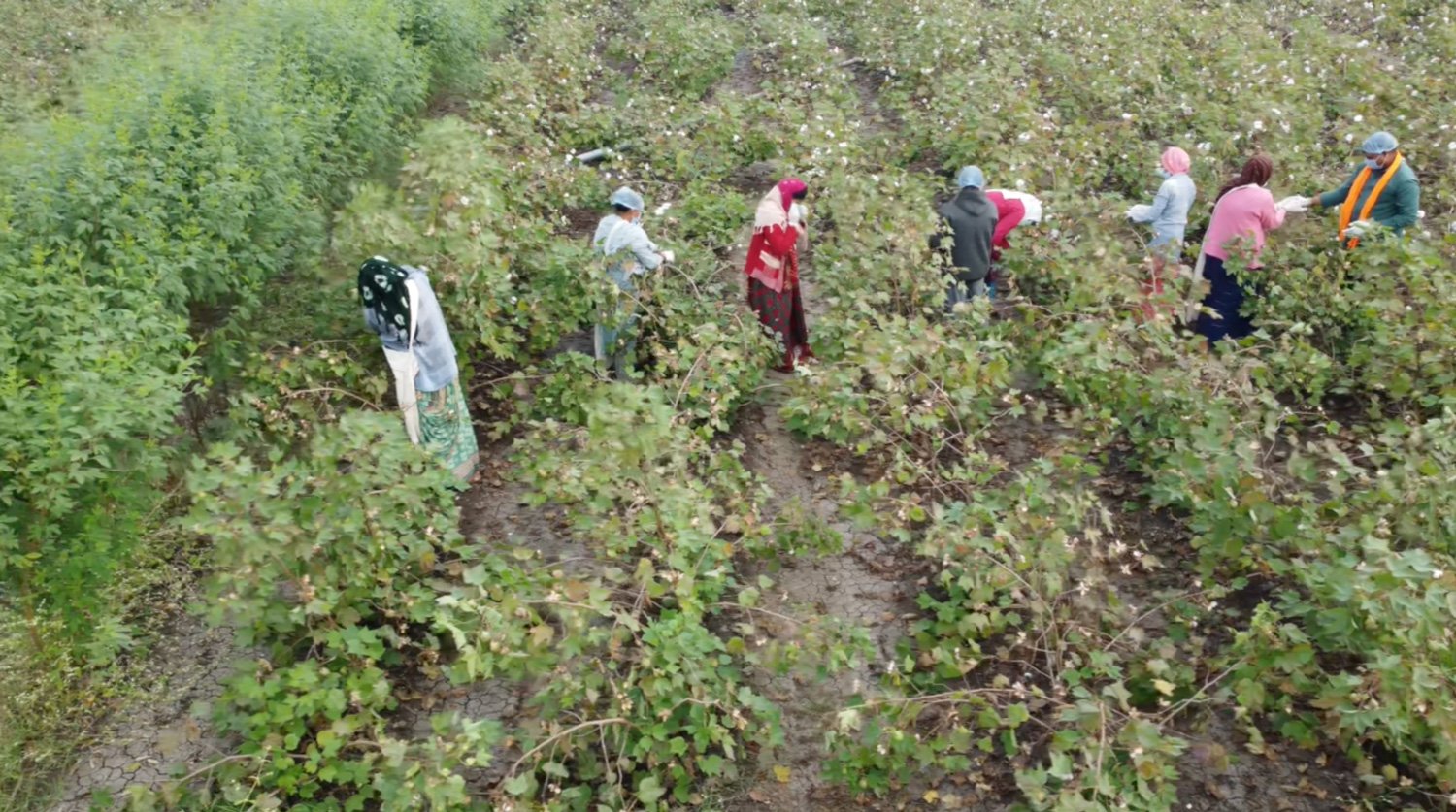
HOW COTTONCONNECT IS WORKING TOWARDS ITS INCOME AND RESILIENCE GOAL
CottonConnect aims to increase the net income and resilience in a sustainable manner for one million cotton farmers and workers by 2030. So far, over 800,000 farmers have participated in CottonConnect’s programmes up to and including 2023-24.
Introducing sustainable agricultural methods which both increase the yield and reduce the expenditure on the use of chemical pesticides and fertilisers can have a significant impact on profit, which means the farmer retains more income.
CottonConnect also support farmers to diversify income sources and increase resilience to the effects of climate change.
HOW COTTONCONNECT IS WORKING TOWARDS ITS WOMEN’S EMPOWERMENT GOAL
CottonConnect aims for 500,000 women to be taking part in Women in Cotton programmes by 2030, with about 270,863 women participating in 2023-24.
The programme provides the background in literacy, numeracy, rights, and health needed to enable women to take advantage of increased livelihood opportunities, both within cotton farming and by running their own enterprises.
The Women Climate Change Ambassadors programme was set up in 2022 to empower women farmers as change leaders in climate resilience. So far, 42 change leaders have since trained 30 farmers each, imparting knowledge of farming practices to adapt to the effects of climate change to over 1,200 women.
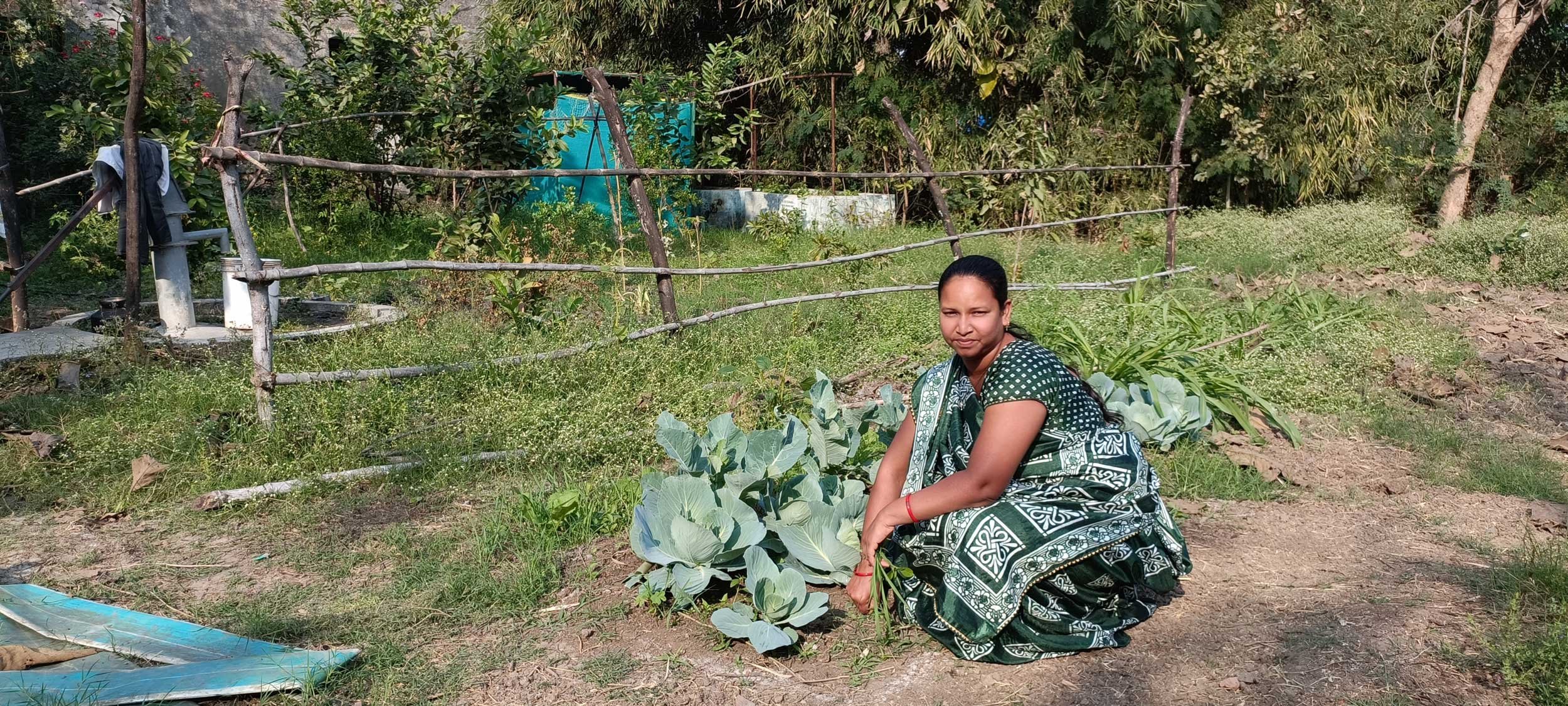
Women taking the lead in teaching climate change mitigation techniques
Nitaben Vijaybhai Tadavi is one of CottonConnect’s Climate Change Ambassadors in Narmada district, Gujarat, India.
Nitaben took part in the intensive Climate Change Ambassadors training programme which trains women farmers in sustainable agriculture techniques chosen specifically to mitigate against further climate change. The in-depth learning includes demonstration activity on the production of vermicompost, biopesticides, and agro-forestry (fruit crop) plantation.
The Women Climate Change Ambassadors are encouraged to further train 30 women farmers in their villages on what they have learned during training programme. Nitaben has so far trained and motivated 29 other women farmers to adopt better sustainable agriculture practices.
Prior to the training, Nitaben was applying chemical fertiliser and pesticides, which negatively impacted soil health and fertility and reduced biodiversity.
During the training, Nitaben learned how to produce homemade natural agri-input like jivamrit and vermicompost, plant fruit crops on the field boundary, and intercrop the cotton crop with pigeon pea. Using bio-inputs Nitaben has reduced external input costs and seen increased production of cotton. During the cotton season 2023-24, she anticipated seed cotton production of 1,000 kg/acre, increased from 700 kg/acre the previous year.
It is expected that using natural agri-input will generate a gradual increase in useful microorganisms in the soil and thereby increase the soil fertility. The planting of a border fruit crop will improve biodiversity and provide an alternate source of income.
Nitaben now regularly produces and uses homemade natural agri-input. Three of the women farmers trained by Nitaben have also started producing homemade natural agri-input.
Nitaben Vijaybhai Tadavi
Gujarat, India
CONTRIBUTION TO UN SDGS
CottonConnect’s programmes increase income and profit from cotton growing for smallholder farmers.
The Women in Cotton programme teaches women how to improve livelihoods including running their own microenterprises.
The REEL Cotton Code specifically requires equal pay for work of equal value. It prohibits forced and child labour, and supports enrolling of children into schools. (REEL Cotton Code v3.0)
The Responsible Business Gins Code of Conduct improves health and safety practices in gins.
CottonConnect’s programmes support income growth of low-income smallholder farmers and workers through increased profit and yield.
The REEL Cotton Code criteria stipulate no discrimination on sex, disability, race, ethnicity, origin, religion or economic or other status. (REEL Cotton Code v3.0)
CottonConnect teaches smallholder farmers about the sustainable management and efficient use of natural resources, e.g. water.
Providing supply chain visibility for brands and retailers to help consumers make informed choices to choose cotton more sustainably grown.
The REEL Cotton Programme reduces field emissions and chemical fertilisers, which contribute to GHG emissions and climate change potential.
Addressing the effects of climate change on cotton cultivation through climate change mitigation pilots, including training women climate ambassadors.
PARTNERSHIPS
Implementing Partners
CottonConnect would like to thank its valuable implementing partners:
India
Self Employed Women’s Association (SEWA);
Shree Ram Fibres India Pvt Ltd Hariraj Charitable Trust
Vasundhara Foundation
Inter Rural Development Institute (IRDI)
Pakistan
Rural Education and Economic Development Society (REEDS)
Bangladesh
CottonConnect also thanks the Cotton Development Board in Bangladesh for its assistance with farmer training in the REEL Cotton Programme in Bangladesh.
Egypt
Farmers
Smallholder farmers are at the heart of CottonConnect’s sustainable cotton programmes, and a trusted partnership has developed over the years working with local implementing partners known to the cotton farming communities.
The REEL Cotton Programme was specifically developed with input from farmers and farmer groups in India, and farmers and implementing partners in several countries continue to be consulted in the revision of the REEL Cotton Code.
As part of continuous feedback with farmers, the 2023-24 impact results in this report will be shared with programme farmers through the implementing partners. CottonConnect first piloted a farmer feedback method in 2022, with programme farmers in Madhya Pradesh, India, and Khulna, Bangladesh. Across both locations, the programme farmers found the impact results helpful, identifying areas where they can perform better than conventional farmers and which areas to focus on for better profits, cost savings and yield. The results from last year’s impact report (2022-23) were shared with farmers as part of this farmer feedback method.
Clients
CottonConnect is pleased to partner with a number of leading brands and companies from across fashion, retail and manufacturing.
COLLABORATIVE PLATFORMS
CottonConnect is proud to have been a member of these organisations during 2023-24.
The REEL Cotton Code is approved as a sustainable standard system for sustainable cotton by the Partnership for Sustainable Textiles. CottonConnect is not a member of the Partnership for Sustainable Textiles.
Awards
CottonConnect won the Partnership and Collaboration of the Year: Education and Empowerment Award at the 2024 edie Awards.
CottonConnect won the Small-Medium Enterprise of the Year Award at the 2024 Reuters Sustainability Awards.
CONCLUSION
REEL Cotton programmes achieved positive results in 2023-24, reducing the use of chemical pesticides, chemical fertilisers, and water, while increasing farmers’ yields and incomes. With increased profits, farmers can invest in their farms, enhancing long-term resilience.
Positive benefits from regenerative agriculture practices are recorded in REEL Regenerative and organic regenerative programmes.
A LCA study demonstrated the benefits of the sustainable practices outlined by the REEL Cotton Code of Conduct in reducing the negative impact of cotton cultivation on the environment across all impact categories, with a climate change saving potential of 35%.
Cotton procurement and processing of all REEL Cotton and REEL Regenerative programmes are traced through TraceBale, with an increase in cotton lint being traced in 2023-24.
Women Climate Change Ambassadors have each trained 30 farmers each, imparting climate change mitigation knowledge to over 1,200 women, confirming the pilot’s training model.
Organic cotton programmes demonstrate the potential for farmers converting to organic farming practices to make profits by reducing input costs and gradually improving yields.
Regular on-site soil testing is needed to measure the impact of sustainable agriculture practices on improving soil health.
Photo credits for the images in Impact Report 2024 are included in the pdf format of the report.
Download the full Impact Report as a PDF document
Learn more about CottonConnect from our website and get in touch for support with your sustainable sourcing goals


